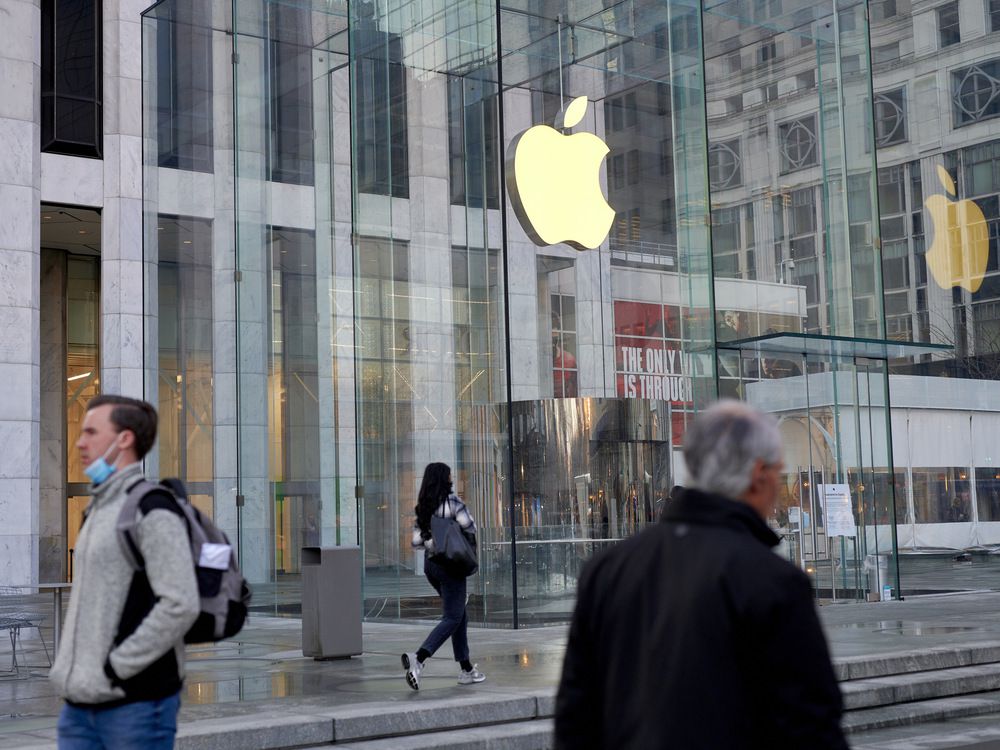Martin Pelletier: Retail investors have been adding risk by buying the dip on high-beta and long-duration stocks. Bond investors are doing the opposite
The herding into large tech stocks has been so pronounced that Apple Inc. reached a 7.1-per-cent weighting in the S&P 500. Photo by Gabby Jones/Bloomberg What a roller-coaster ride the markets have been on over the past few weeks, as commodities such as oil rocketed and then sold back down only to be replaced with investors buying the dip in tech-heavy segments of the market such as the Nasdaq and the S&P 500, thereby erasing more than half of those indexes’ losses this year.
Advertisement 2 This advertisement has not loaded yet, but your article continues below.
The herding into large tech stocks has been so pronounced that Apple Inc. reached a 7.1-per-cent weighting in the S&P 500, the largest for any individual company going back to 1980, according to Charlie Bilello, chief executive of Compound Capital Advisors LLC.
Goldman Sachs Group Inc. research, meanwhile, points out that US$93 billion flowed into equities this year, which contrasts to historical outflows of US$10 billion during a median 10-per-cent correction over the 12 weeks following a market peak.
Equity market participants, particularly retail investors, have been adding risk to their portfolios by buying the dip on high-beta and long-duration stocks, but bond investors are doing the opposite. This is shown by the SPX Volatility Index retreating to its start-of-the-year levels while the U.S. Bond Volatility Index has skyrocketed above where it was during the COVID-19 meltdown in March 2020.
Advertisement 3 This advertisement has not loaded yet, but your article continues below.
The World Government Bond GDP-Weighted Return Index is down an annualized 18 per cent this year, which puts it near the extreme levels reached during the Marshall Plan, the United Kingdom going off the gold standard and the Treaty of Versailles.
The decision of whether to listen to institutional bond participants managing risk or retail stock investors chasing it is a rather easy one.
The problem for retail investors is that central banks, including the United States Federal Reserve and Bank of Canada, got caught behind the eight ball, since they believed inflation was transitory and were too slow to adjust their monetary policies as a result. In hindsight, they should have begun tapering last year, so now they need to play catch-up in an environment where the yield curve has just inverted, signalling the potential for a recession.
Advertisement 4 This advertisement has not loaded yet, but your article continues below.
This is exactly where the difference of outlook comes in, because retail participants are betting central bankers will not raise rates as fast or as high as bond markets are factoring in. Instead, they’re choosing to believe inflation will eventually prove temporary and the risks of a recession are too great for central banks to be in tapering mode.
However, let’s not forget the U.S. has record low unemployment numbers, strong household savings and consumers eager to get back to pre-pandemic lifestyles. Meanwhile, supply channels continue to be interrupted and underinvested in, and inflation has been left to run unchecked for the past year, with the only response so far being a 25-basis-point hike.
What’s an investor to do? Well, we’re underweight fixed income — at the lowest levels we’ve ever been — with a focus on U.S. floating rate notes complemented by a bit of inflation-protected notes. We’ve also significantly reduced our Canadian bond exposure, because we’re worried about both the potential for Bank of Canada policy error risk, and household and government sensitivities to higher rates. We’ve also offset some of this by overweighting structured notes, a hybrid between stocks and bonds, which we think is a great tool for adding risk-managed returns in the high single digits.
Advertisement 5 This advertisement has not loaded yet, but your article continues below.
More On This Topic Duration risk doesn’t end with bonds, and it’s something equity investors better realize Navigating the battle between old and new, good and evil Four ways Canadians can protect themselves from a worsening market situation A tactical portfolio rebalancing can cut your risks in troubling times As for equities, we’ve been actively managing our duration risk, choosing to focus on the lower volatility and value segments of the market. They are not as sexy as the market high flyers, but we like their stability and predictability.
Finally, even though I talk a lot about energy, it only has a weighting of 10 to 15 per cent in our portfolios, primarily as an inflation hedge. Oil prices are selling off, but oil equities are still discounting lower prices and generating a pile of cash flow. This is complemented by a position of 2.5-to-5 per cent in commodities (agriculture, gold, energy and materials) through some active managed funds, exchange-traded funds and stocks.
Martin Pelletier, CFA, is a senior portfolio manager at Wellington-Altus Private Counsel Inc, operating as TriVest Wealth Counsel, a private client and institutional investment firm specializing in discretionary risk-managed portfolios, investment audit/oversight and advanced tax, estate and wealth planning.
_____________________________________________________________
For more stories like this one, sign up for the FP Investor newsletter.
______________________________________________________________
Financial Post Top Stories Sign up to receive the daily top stories from the Financial Post, a division of Postmedia Network Inc.
By clicking on the sign up button you consent to receive the above newsletter from Postmedia Network Inc. You may unsubscribe any time by clicking on the unsubscribe link at the bottom of our emails. Postmedia Network Inc. | 365 Bloor Street East, Toronto, Ontario, M4W 3L4 | 416-383-2300
